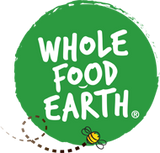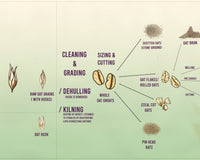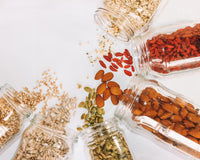Veganism is certainly increasing in popularity across the UK and there are many ways to embrace vegan living - whether it’s the clothes you wear, the products you use on your skin, the entertainment you watch, and of course your daily diet.
The Vegan Society describes veganism as a philosophy and lifestyle which seeks to eliminate animal exploitation, particularly from food and clothing production, while promoting the benefits of animal-free alternatives. This includes cutting out meat, dairy, and anything else derived from animals, from your diet.
The environmental, health, and ethical benefits of veganism are beyond doubt, but whether you are a lifelong meat-eater, or have already made the move to vegetarianism, it can be hard to know where to start. Here, we have outlined six simple steps to help you on your journey.
Step One: Commitment and Timescales
It’s important to understand that for most embracing a vegan lifestyle is less of an overnight feat, and more of a gradual transition as you seek out what works best for you – don’t be concerned if you feel you need more time. Keep your end goal in mind, but go at your own pace.
For some, trying a meat or dairy-free day a week is a good starting point, perhaps then moving on to incorporating one vegan meal into each day and increasing this as you feel you are able. Others find it best to swap out a product at a time with the growing number of plant-based alternatives available - be it milk, mayonnaise, or yoghurt.
Step Two: Researching the Products You Regularly Consume
Taking a deep dive into your fridge and kitchen cupboards is a must before fully committing to a vegan diet. You may be surprised to find that some of your favourite foods contain ingredients either wholly or partly derived from animals.
To help ensure that you don’t get caught out, here are some examples of unexpectedly non-vegan foods:
-
Dark chocolate
Cocoa itself is vegan, but sometimes milk or milk products are added to dark chocolate. Check the ingredient list for dairy (including whey and casein). -
Sweets
Sugary sweets like gummies and marshmallows may contain gelatine, a product derived from animal collagen, so keep an eye out at the pick & mix. -
Red foods
Some red-dyed food and drinks, such as yoghurt, juices, and sweets, may contain an ingredient called carmine (or cochineal), which is derived from the cochineal insect. Take note of the ingredient list on foods made with red dye. -
Veggie burgers
Many veggie burgers contain eggs or dairy, so check the labels. -
Honey
Honey can be a little divisive among the vegan community as it comes from bees. Many, but not all vegans choose to avoid honey.
Step Three: Learn to Cook Vegan
Cooking for yourself, and your friends and family from scratch can be a really satisfying process, especially when you know that it’s filled with goodness from vegetables and wholegrains central to vegan cooking. Learning some recipes will help you to try new flavours and ingredients that perhaps you haven’t before, so you can discover the fullness of vegan cuisine and unearth your favourite dishes.
In addition to fresh fruit and vegetable, make sure your pantry is filled with items such as nuts, beans, rice, flour, dried fruit, breakfast cereal and granolas, pasta and noodles, nut butters, and tahini, so you’re always ready to rustle up your next meal - all of which you can find in our online store.
With just a little practice and exploration, you’ll be on your way to becoming an accomplished vegan cook. We at Wholefood Earth are looking forward to sharing some nourishing vegan recipes that we have been developing very soon. To be among the first to access these please subscribe to our mailing list.
Step Four: Learn to Meal Prep
The availability of vegan products in supermarkets means you can adopt the diet much more easily than before, yet for a novice hoping to pick up some convenience food, a trip to the shops can still lead to lapping the aisles and getting lost in labels.
This is where the art of meal prepping comes in. Preparing whole meals or dishes ahead of schedule not only means that you have a selection of nutritious vegan food just waiting to be eaten, it is budget-friendly, helps you stick to your new diet, and saves time during the busy week. Get those containers at the ready…
This is a great opportunity to put your new-found vegan recipes to the test and spend a Sunday afternoon honing your skills and creating a delicious array of meals for the week ahead.
Step Five: Getting the Right Nutrition
Improved health is a key motivation for many choosing to become vegan – it is widely known that eating more fruit and vegetables can decrease the risk of diseases such as bowel cancer while consuming more wholegrains, soy, and nuts, are known to help protect your heart.
While the British Nutrition Foundation points out that a well-balanced vegan diet should give you the vitamins and minerals you need, there can be a risk of nutritional deficiencies - this can include a lack of calcium, omega-3 fatty acids, and vitamins B12 and D.
Plant milk, yoghurt alternatives, soya, and linseed bread fortified with extra calcium should be considered for your new diet. Also, to get enough omega-3 fatty acids it is advised to regularly consume chia seeds, ground linseed, hemp seeds, and walnuts.
Vitamin B12 is commonly found in meat, eggs, and fish and a drop in levels will leave you feeling exhausted - eating fortified foods such as dairy alternatives, breakfast cereal, dairy-free spread, and yeast flakes will help combat this. Also, many of the foods highest in vitamin D, such as salmon, egg yolks, and shellfish, aren’t vegan-friendly. To help maintain levels, try fortified cereals and milks, as well as mushrooms.
Step Six: Make It Accessible
Now that you know more about the types of food and drink you should be looking for, and how to prepare them, one of the best things you can do to help ensure the success of your vegan journey is to make sure that your pantry is full to the brim with plant-based power.
Here at Wholefood Earth, you can find a whole range of affordable healthy wholefoods and sustainably sourced products. Grab some cereals & flakes, perfect for breakfast muesli or granola, or some nuts, seeds & fruits for snacking. Stocking up on a variety of flours & grains, will no doubt form the bases for much of your batch cooking and minerals & salts will help season your culinary creations. Your kitchen cupboards will never be the same again!
You’ve Got This!
By following the steps above and believing in yourself, vegan living will soon become second nature. Take your time, don’t give up, and remember all the positive reasons why you have chosen this path.
You've chosen an amazing, inspiring, and ethical way to live your life – be sure to enjoy it!






